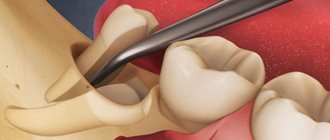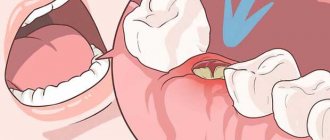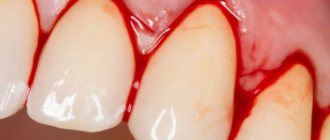Types of removal Causes of complications How long does the pain last What is the pain associated with?
Aching jaw Painful to swallow Throbbing pain How to relieve pain? Recommendations after removal Dental treatment can be therapeutic or surgical, and pain can occur after any type of intervention. If your wisdom tooth hurts after treatment, in most cases, this is a normal physiological reaction of the tissues to the procedure performed. Usually, painful sensations are quickly relieved with painkillers and go away on their own within a couple of days. But there are situations when pain after removal of the figure eight occurs due to complications or a violation of the technology of the therapeutic manipulation.
The dentist will definitely consult the patient about how the recovery process after the intervention should normally proceed, and if any symptoms appear, you should immediately consult a doctor. If all the doctor’s recommendations regarding the rehabilitation period are followed, but the painful sensations only increase, this is a direct indication to come for another appointment.
Types of deletion
Wisdom teeth (eights, third molars) are larger than other dental units in the row. They differ not only in size, but also in the complex anatomy of the root system. Eight has from 2 to 6 roots
, which are often closely intertwined with each other. Given the complex arrangement of wisdom teeth, when they are removed, a significant wound is created.
The risk of complications will directly depend on how difficult the figure eight extraction was. With simple extraction, when the tooth is intact, the roots are not intertwined, and there are no other pathologies (pulpitis, periodontitis, etc.), the risk of complications is minimal. In such a situation, the doctor uses forceps or an elevator to remove the tooth from the socket.
If the wisdom tooth is incorrectly positioned (horizontal eruption, severe curvature), intertwined roots, significant destruction of the coronal part, or the presence of inflammation, a more global surgical intervention may be required. An incision in the gum, cutting a tooth into pieces with a drill, removing root fragments through the jaw bone and other manipulations significantly increase the traumatic nature of the procedure. Aching pain, swelling after removal of the figure eight, increased temperature (up to 37.5℃), hematoma on the cheek - this is a normal reaction to the intervention, which lasts no more than 5-7 days.
Why does my gum hurt?
Unexpressed aching pain and slight swelling of the gums appear due to injuries to soft tissues, nerves, and jaw bone when removing a tooth from its bed. The gum tissue swells, the nerve endings are compressed, hence the pain. How much your gums hurt after tooth extraction depends on:
- Patient's pain sensitivity;
- degree of complexity of the intervention;
- features of the clinical case;
- location of the dental unit (after extraction of molars, the injury is greater, the pain lasts longer);
- state of immunity.
The body’s normal response from the development of complications is distinguished by the following properties: the pain does not intensify, pathological symptoms are present for no more than 7 days, and no other signs of deterioration in well-being are observed.
Why complications arise
After extraction, a wound is left in the gum and bone in which a blood clot (fibrin) forms. It “seals” the wound, preventing infection, and becomes the basis for the formation of new tissue that fills the space formed after the removal of the 8. After uncomplicated removal, healing lasts about a week. On days 3-4, the blood clot is gradually replaced by granulation tissue, which gradually fills the entire socket. Already after a month, the granulation tissue is completely replaced by connective tissue, and after 3 months - by bone.
Removal of third molars can have negative consequences that appear almost immediately after the intervention. Among the most common complications:
- “dry socket” - when a blood clot does not form or dissolves too quickly;
- paresthesia - damage to the nerve endings around the removed unit;
- alveolitis - inflammation of the socket;
- bleeding;
- cyst - fibrous formation at the site of an extracted tooth;
- endogenous periostitis (flux).
In rare cases, stomatitis, osteomyelitis, jaw trauma, and perforation of the bottom of the maxillary sinus are observed. The occurrence of complications is usually associated with ignoring the dentist’s recommendations regarding oral hygiene during the healing period, decreased immunity, and violation of surgical technique.
Why does a pulled out tooth hurt?
The presence of pain after tooth extraction is due to the fact that soft tissues, blood vessels and nerves are damaged during tooth extraction. Typically, the first pain symptoms appear 3-4 hours after surgery. This is due to the fact that this is when the anesthesia stops working.
Also, during removal, the bone tissue of the jaw socket may be damaged. In this case, the pain during the healing period is more intense and prolonged. However, if the removal was carried out correctly, it will soon pass.
How long does it hurt?
In most cases, pain during removal worsens on the second day. On the third day they begin to decrease. By the fourth or fifth day, there is practically no pain. If by this period the pain after tooth extraction does not subside, the patient should consult a doctor, as this may indicate the emergence of complications.
However, it is important to remember that complete healing of the hole occurs only in the second or third week after the procedure. Until this time, the gums and bone tissue are vulnerable, so if they are irritated, pain may also occur. To prevent this from happening, you should follow your doctor's recommendations.
Headache
The recovery period after tooth extraction may be accompanied by headaches of varying intensity. They are associated with damage to the nerve fibers that go to the brain. Such symptoms should not frighten the patient, since as the wound heals, they will also pass.
Another cause of headaches during this period may be hypertension. The patient must notify the attending physician about the presence of such an illness. In this case, the surgeon will be able to select appropriate medications that will reduce pain.
Ear pain
For the same reasons, a patient may experience unpleasant or even painful sensations in the ear after tooth extraction. Most often they have a shooting character. This symptom is also normal and goes away in the coming days after the intervention.
Ear pain may worsen if, after the procedure, the patient does not properly care for the oral cavity and tries to chew solid food.
Pain in the gums
Pain in the gum is associated with its direct damage. In this case, not only the soft tissue suffers, but also the nerves, which are also located in the gums. Depending on the degree of damage, pain can last for different times and occur with greater or less intensity.
Increased pain in the gum may indicate the presence of fragments in its tissues, as well as the occurrence of one or another complication. If such symptoms occur, you should immediately consult a specialist.
Pain after wisdom tooth removal
Patients are always interested in the question, how many days does the jaw hurt after wisdom tooth removal? Pain after surgery is a standard tissue response to injury. Normally, the pain subsides within a few hours or within 3 days after extraction (in case of complicated removal). The pain a patient experiences after wisdom tooth removal indicates the success of the procedure.
- The first discomfort and pain appear 2-3 hours
after the intervention (when the anesthetic wears off). - The first 3-4 days
there is aching pain, redness and swelling of the soft tissues. If the extraction is successful and the hole is properly cared for, the pain will gradually disappear. - Over the next 2 weeks
, if there are no complications, the wound will heal completely, and minor pain may occasionally occur in the late afternoon. - After 3 weeks,
all discomfort should disappear.
If a wisdom tooth has been pulled out and it hurts for more than 5 days, the intensity of the pain increases, it becomes throbbing, debilitating, accompanied by fever, swelling - this indicates a complication and requires immediate medical intervention.
Simple and complex removal
How complex the operation will be directly depends on the location of the eighth molar, the correctness of its growth, the complexity of the root system and the integrity of the tooth being removed. For example, if there is severe caries damage, the doctor will have to cut it into several pieces and only then remove it.
Easy removal
Simple extraction is the extraction of a tooth using forceps, without the help of any other dental instruments. During a simple extraction, the molar is easily removed from the gums, usually without complications. Most often, figure eights of the upper jaw are removed this way, because they are clearly visible and their roots are located exactly in the gum. In rare cases, there is a problem with the removal of upper molars. Accordingly, tissue regeneration also occurs quickly. On the 3-4th day, instead of a blood clot, young connective tissue forms, after 2-3 weeks filling the entire depth of the hole. On average, bone tissue is formed after 3 months.
Complex removal – what to expect?
Complex removal is one that requires drilling out the jawbone or cutting through soft tissue. This is mainly required when extracting figure eights from the lower jaw, since the root system here is more complex. Often there is abnormal growth (impacted or dystopic tooth), in which case only complex extraction is indicated. In the area of the lower jaw, the vessels pass close to the root system and there are more nerve endings, so it is always more difficult to remove lower molars. If the doctor considers it necessary, stitches are applied after the operation.
How long pain and healing last after wisdom tooth removal depends on the following factors: the presence of an inflammatory process during the procedure, the complexity of the operation, the degree of trauma after removal, the characteristics of the body, proper hygienic care, and taking medications after surgery. A timely operation is accompanied by rapid tissue regeneration, without the need for antibiotic therapy.
Attention! A wisdom tooth hood is a soft tissue that covers an impacted tooth. This is an “extra” formation in the oral cavity, and it is very important to remove it before inflammation begins. The hood is an additional source of inflammation. If it is not excised in time, an inflammatory process may begin and antibiotics may be required.
What could be causing the pain?
If the pain after removing the figure eight does not subside within 5-7 days, but rather intensifies, this may indicate the following complication:
- Alveolitis
is an inflammation of the socket associated with the absence of a blood clot, poor hygiene, infection of the wound, or the presence of a bone fragment in the socket (if the tooth was extracted in parts). - Severe damage to the blood vessels
of the surrounding tissues - in addition to pain, there is a hematoma, swelling of the gums and cheeks. - Allergy
to anesthetic, hemostatic sponge (if it was used during the procedure).
As inflammation develops, pain is accompanied by an unpleasant odor, purulent discharge from the socket, the formation of gray plaque, enlarged lymph nodes, increased temperature, and deterioration in general well-being. In this case, you need to see a doctor immediately.
Aching jaw
When the jaw hurts after wisdom tooth removal, it is usually due to the fact that the surgeon put pressure on it to gain access to the molar. Or during the procedure, blood vessels, nerve endings, and ligaments of adjacent dental units were injured. These symptoms are quite normal, if there is no difficulty opening the mouth, there is no pronounced swelling of the gums or soft tissues of the face.
It hurts to swallow
After extraction of the lower 8, you may experience a sore throat or pain when swallowing. This symptom appears against the background of severe damage to soft tissues, with severe swelling of the gums, cheeks, or due to trauma to the trigeminal nerve. If the trigeminal nerve was affected during the operation, there is not only pain, which can radiate to the temple, ear, neck, but numbness on the face, in the area of the removed unit, and increased salivation. Also, a sore throat may occur if there is inflammation or purulent process around the affected molar. This symptom can last up to 2 weeks. To avoid complications, you should visit a neurologist or dentist.
Throbbing pain
If your gums ache after wisdom tooth removal, but the discomfort is quickly relieved with an analgesic and disappears after 2-3 days, this is evidence of normal healing. On the contrary, throbbing pain in the jaw or gums indicates possible inflammation, damage to blood vessels and nerves. With neuritis (damage to the jaw nerves), it can radiate to the neck, throat, temple, ear, eye. The pain increases, prevents you from falling asleep, and interferes with normal life - in this case, you need to immediately consult a dentist, this is a sign of inflammation.
Possible complications
There are several reasons why complications arise after the removal of the eighth molar: improper oral care, inexperience or negligence of the surgeon, complex removal with severe trauma to the gums. The most common complications include:
- Paresthesia.
If the nerve endings are damaged, the cheeks, lips, tongue and chin become numb. Possible diction problems. Symptoms may last up to two weeks.
- Alveolitis.
The most common complication after removal of the eighth molar. Development is provoked by an incompletely removed tooth or an open socket, without a blood clot. The “true friend” of such a complication is bad breath, which does not go away for a long time.
- Hematomas.
The reasons for the appearance are damaged blood vessels during removal.
- Flux.
If hygiene is not observed, bacteria enter the wound, which provokes inflammation of the periosteum. Symptoms: pain, fever, redness and swelling of the gums.
If severe pain after the removal of a wisdom tooth does not subside, but rather intensifies, symptoms such as swelling, bruising and edema progress - this is already a pathological process that requires the intervention of a specialist.
How to relieve pain and discomfort
- Do not touch the blood clot in the socket with your tongue, toothbrush, hands or foreign objects;
- make oral baths from herbal decoctions and antiseptic solutions;
- if the pain radiates to the ear or another part of the head, take a painkiller;
- exclude hot food and drinks.
If your gums hurt for several days after wisdom tooth removal or you have a headache, you don’t need to worry too much. Analgesics prescribed by your dentist will help you cope with these symptoms. If the discomfort does not go away after a week, painkillers do not help much - you need to go to the doctor. If the temperature is above 37.5℃, which does not decrease to normal, the development of an allergic reaction (to an analgesic, hemostatic sponge), or a sharp deterioration in health, you should consult a doctor immediately.
Visiting the dentist if you have a cold
There is no consensus regarding the possibility of dental treatment for colds; doctors act according to the circumstances. For example, acute toothache is the basis for immediate treatment. In certain situations, the patient does not want to reschedule a visit to the doctor; clinic staff have the right to refuse to provide services in order to prevent infection of other patients.
Explanations from a qualified specialist will help you make the right decision and cancel your planned visit to the dentist. Dental treatment is accompanied by the risk of injury to the gums; wounds are a “road” for infection. In addition, painkillers can become a cause of deterioration of well-being during ARVI. A cough and runny nose are an obstacle to the dentist’s manipulations; the patient cannot stand it with his mouth open for a long time. Pauses have a negative impact on the quality of treatment; in addition, the possibility of infection of the doctor cannot be ruled out.











